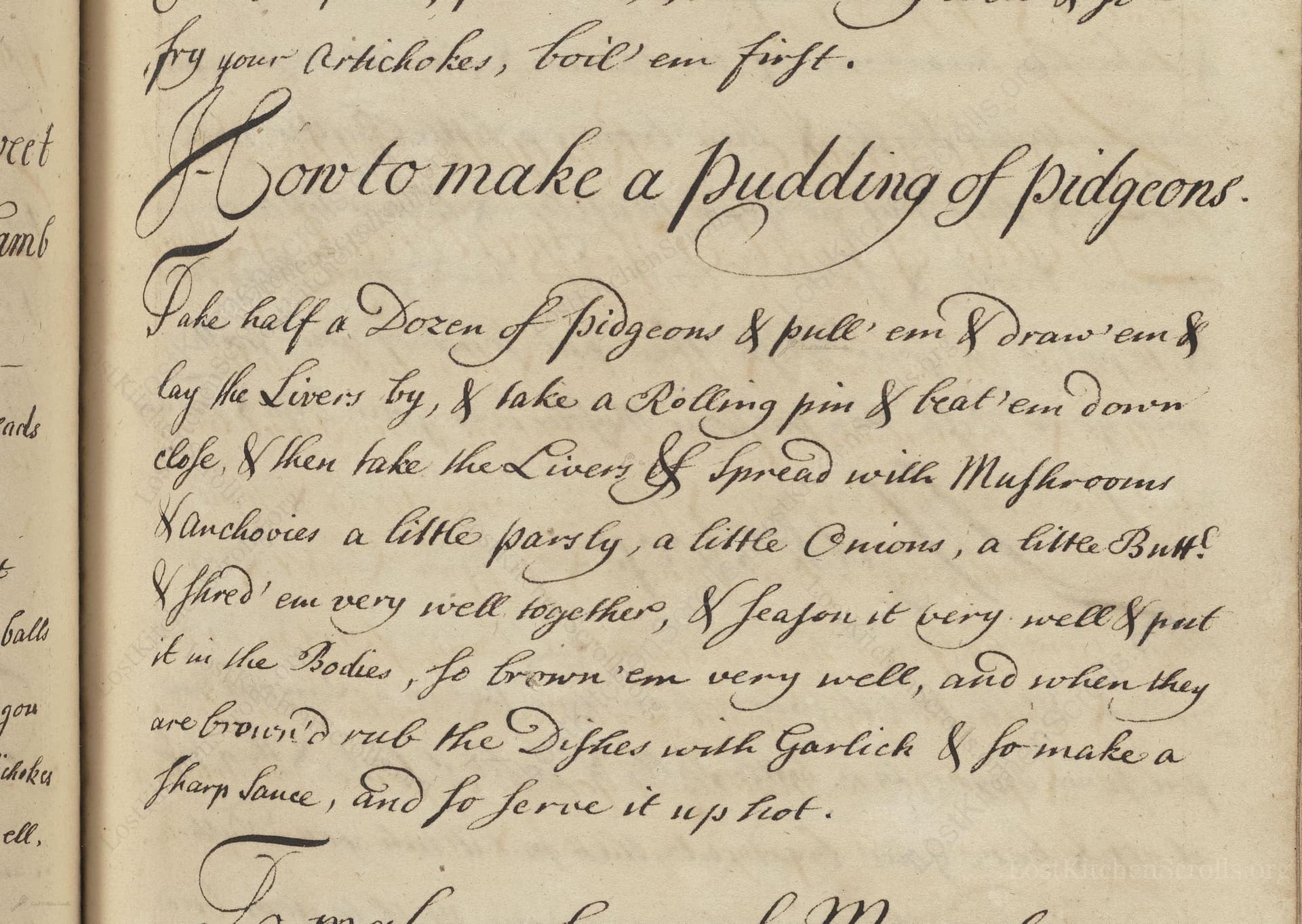How To Make A Pudding Of Pidgeons
From the treasured pages of Various Cookeries
Unknown Author

How To Make A Pudding Of Pidgeons
"Take half a Dozen of Pidgeons & pull 'em & Draw 'em & lay the Livers by, & take a Rolling pin & beat 'em down close, & then take the Livers & shred with Mashrooms Anchovies a little parsly, a little Onions, a little Butter & shred 'em very well together, & season it very well & put it in the Bodies, so brown 'em very well, and when they are brown'd rub the Dishes with Garlick & so make a sharp sauce, and so serve it up hot."
Note on the Original Text
Early modern English recipes favored direct, imperative phrasing with minimal measurements, assuming an experienced cook. Spelling was idiosyncratic: 'Butt'r' for butter, 'Mashrooms' for mushrooms, and 'Anchovies' spelled phonetically. Quantities and timings are absent; the cook was expected to adjust based on context and experience. Ingredients lists were integrated into the method, not set apart—a style that modern cookbooks no longer follow.

Title
Various Cookeries (1690)
You can also click the book image above to peruse the original tome
Writer
Unknown
Era
1690
Publisher
Unknown
Background
A delightful glimpse into late 17th-century kitchens, this book brims with recipes, methods, and culinary wisdom passed down through generations, capturing the essence of historical gastronomy.
Kindly made available by
Folger Shakespeare Library
This recipe hails from the late 1600s, an era in England when savory pies and puddings were central to both noble and household feasting. Pigeons were a common source of protein for affluent diners, with 'pudding' referring less to dessert and more to stuffed, encased, or sauced dishes. The combination of mushrooms and anchovies reflects the period's fondness for rich, umami flavors, and the use of garlic, vinegar, and herbs captures the interplay of sharp and earthy tastes in post-medieval British cookery. Such recipes were often shared among the educated elite, preserved in manuscript cookbooks, and the style reveals both an experimental spirit and a delight in bold, robust flavors lost in later restrained English cuisine.

Cooks of the period used a combination of open fire, cast iron or brass skillets, and heavy wooden rolling pins. A sharp knife would slice the small ingredients; a mortar and pestle might further break down the stuffing mixture. Dishes and serving platters were typically earthenware or pewter, and the garlic-rubbing would have been done with cut cloves against a cool, hard surface. Pans were deglazed over high flame, sometimes by quickly adding vinegar or wine directly into the hot pan.
Prep Time
20 mins
Cook Time
30 mins
Servings
6
We've done our best to adapt this historical recipe for modern kitchens, but some details may still need refinement. We warmly welcome feedback from fellow cooks and culinary historians — your insights support the entire community!
Ingredients
- 6 pigeons (substitute: 6 young chicken thighs or quail if unavailable)
- 2 oz fresh mushrooms, finely chopped
- 2 anchovy fillets, chopped
- 1 tablespoon fresh parsley, minced
- 2 tablespoons onion, minced
- 2 tablespoons (1 oz) unsalted butter
- Salt and black pepper to taste
- 1 clove garlic
- 2 tablespoons vinegar (wine or cider recommended)
- 3 tablespoons (1.7 fl oz) chicken or game stock
Instructions
- Begin with 6 pigeons, plucked and cleaned, retaining their livers.
- Lay the pigeons flat and use a rolling pin to lightly flatten them.
- Finely chop the livers, 2 oz of fresh mushrooms, 2 anchovy fillets, 1 tablespoon of fresh parsley, 2 tablespoons of minced onion, and 2 tablespoons (1 oz) of butter.
- Mix this stuffing thoroughly and season well with salt and pepper.
- Fill each pigeon cavity with the stuffing.
- In a heavy skillet with a little butter, brown the pigeons on all sides until well-colored.
- While browning, rub the serving dish with a cut clove of garlic.
- Prepare a sharp sauce by deglazing the pan with 2 tablespoons of vinegar and a splash of stock, then pour this over the pigeons.
- Serve hot.
Estimated Calories
350 per serving
Cooking Estimates
It takes about 20 minutes to prep the ingredients and 30 minutes to cook the pigeons. Each serving has around 350 calories, and this recipe serves 6 people.
As noted above, we have made our best effort to translate and adapt this historical recipe for modern kitchens, taking into account ingredients nowadays, cooking techniques, measurements, and so on. However, historical recipes often contain assumptions that require interpretation.
We'd love for anyone to help improve these adaptations. Community contributions are highly welcome. If you have suggestions, corrections, or cooking tips based on your experience with this recipe, please share them below.
Join the Discussion
Rate This Recipe

Den Bockfisch In Einer Fleisch Suppen Zu Kochen
This recipe hails from a German manuscript cookbook compiled in 1696, a time whe...

Die Grieß Nudlen Zumachen
This recipe comes from a rather mysterious manuscript cookbook, penned anonymous...

Ein Boudain
This recipe comes from an anonymous German-language manuscript cookbook from 169...

Ein Gesaltzen Citroni
This recipe, dating from 1696, comes from an extensive anonymous German cookbook...
Browse our complete collection of time-honored recipes



